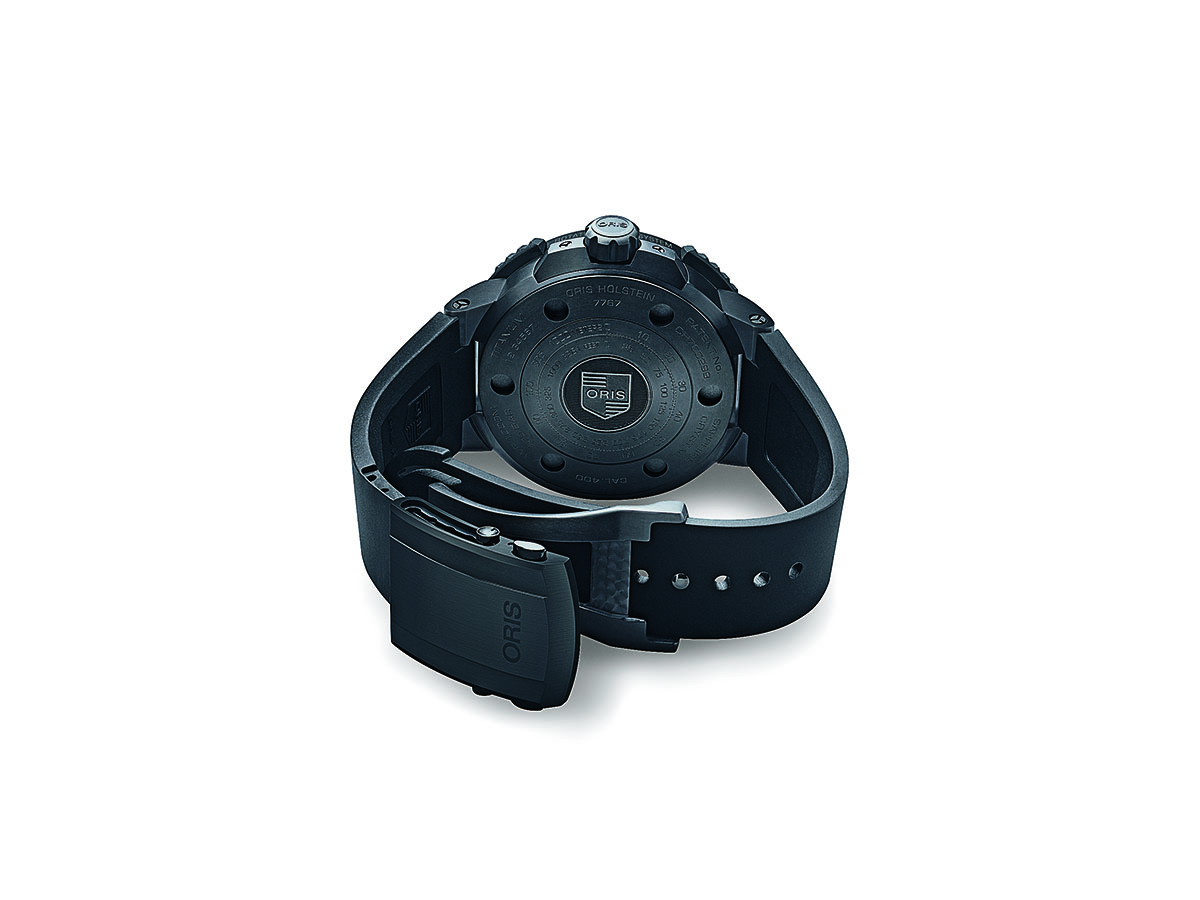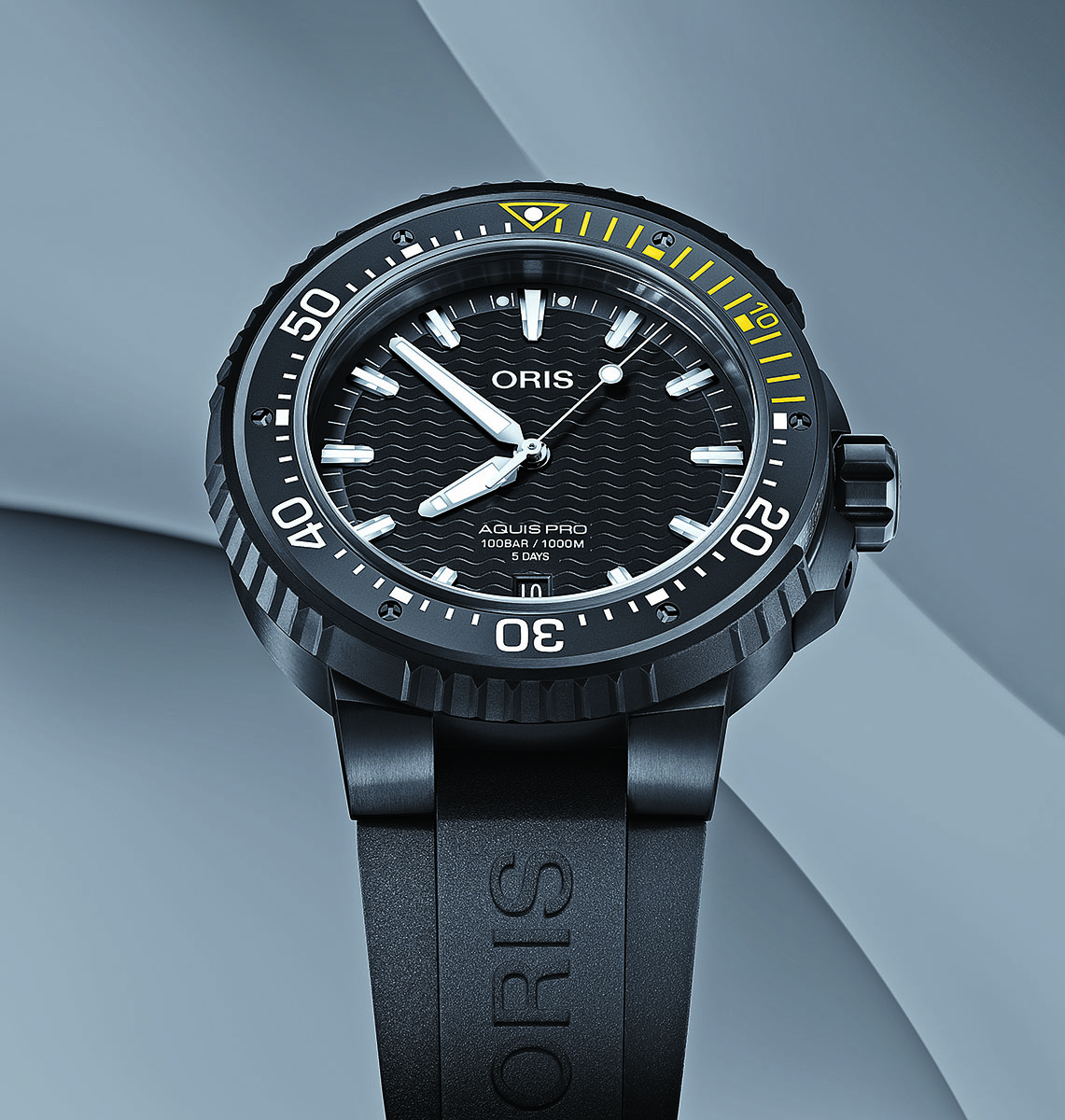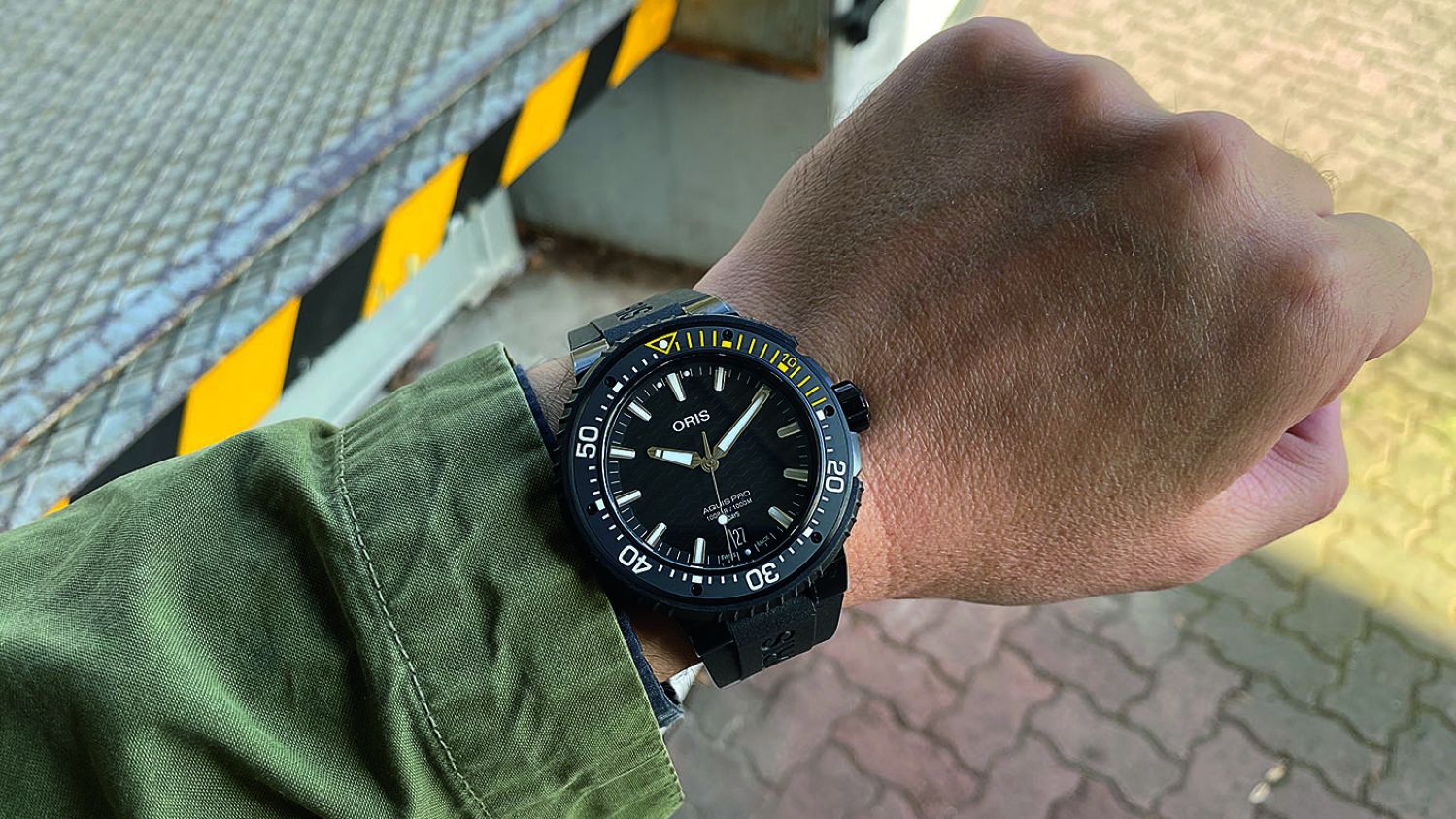The horological market has witnessed many dive watches for decades but when it comes to a fully equipped professional diver’s watch that withstands higher pressures, offers maximum safety, and is easy to operate, the Oris AquisPro Date stands out the most. We tested the Oris AquisPro Date and it had outstanding properties compared to most diver’s watches, with higher water resistance, patented safety mechanisms, and easy operating mechanisms.
A Robust Case
The very large, 49.5mm case is made of DLC-coated titanium and stays water resistant to a depth of 1,000 metres, thus offering sufficient reserves for sport and professional divers in any situation. The crown screws shut and is flanked by protectors that guard it against impacts. The graduated insert in the bezel is made of scratch-resistant ceramic. Oris has anti-reflective coating applied only to the underside of the curved sapphire crystal, which results in two advantages. First, nothing but a diamond can scratch the crystal’s hard upper surface, and second, the bluish shimmer that’s typically seen on a watch glass with anti-reflective coating on both sides, which always looks a bit awkward on a black watch, does not appear here in any lighting situation.
The curved, fully threaded caseback protects against penetration by water. The depth of the six grooves for the tool that’s used to open the case shows just how thick this screw-in caseback really is. Incidentally, the back has a circular scale for converting between feet and metres. This is an interesting item of additional information, but the scale is difficult to read due to its small size and the deep black DLC coating.
Maximum Security
For dive watches, it is not only important to have a high degree of water resistance, but also a bezel that can only be turned counterclockwise. If the scale becomes misaligned during a dive, for example, because the watch scrapes against the diver’s equipment, then the bezel will show a longer interval than the amount of time actually spent underwater. The diver will therefore begin returning to the surface earlier than planned but never later. Another effective safeguard is the use of internal rotating rings, which can be fixed in place after setting via an additional crown, thus making unintentional rotation impossible.
Oris combines both protective measures in a patented mechanism called the Rotation Safety System. This arrangement consists of a metal ring that runs around the rotating bezel and has a grooved rubber coating. When you pull this ring upward, it engages with the flank of the dive-time bezel so the bezel can now be reset to correspond with the minute hand. If you push the ring down again, the bezel is locked in place to show the desired time. The ring can still be turned, but it doesn’t carry the dive-time scale along with it.
But what if you forget to press the ring down before a dive? Then you still have the same level of safety that is provided by a conventional dive watch because Oris has opted for a unidirectional rotating bezel.
The safety aspect of a professional dive watch also includes a helium-release valve, which our Oris model has. It lets breathing gases, which accumulate inside the watch case during several days of operation in pressurised deep-sea chambers, escape safely when the watch and its wearer ascend inside a diving bell. This feature prevents excess pressure from building up inside the case when the external pressure drops, which in extreme situations could cause the watch crystal to crack or pop off.
But that’s by no means the end of the story when it comes to safety. As it has done with the rotating bezel, Oris has also invented a clever and patented solution for the strap. The innovation is an arrowhead-shaped end on the strap that cannot slip out of the clasp. This so-called “safety anchor” comes into play if you have not completely inserted the pin into the desired hole when adjusting the length of the strap and also have not properly pressed the clasp shut. Admittedly, each of these errors is unlikely and both of them together are highly unlikely, but as the saying goes, better safe than sorry.
Despite the safety anchor, the strap can be opened completely, for example, to read the conversion scale on the caseback. To do this, simply squeeze the arrowhead-shaped end of the strap and slide it out of the clasp.
 The two-coloured execution of the bezel can also be seen at night
The two-coloured execution of the bezel can also be seen at nightConvenient Operation
The clasp has other advantages that not only increase safety, but also enhance utility and comfort. The basic design as a folding clasp that opens on one side with safety pushers is pleasing. The system impressed our editors, who regard it as the easiest and most reliable to use. There is also a quick-release extension that has five steps to add a maximum of 18mm, which means that the strap can be lengthened while being worn and, with a little skill, shortened while on the wrist afterward. Two additional round push pieces are used for this.
The convenient operation continues with the large, easy-to-grip, screw-down crown. The black DLC-coated crown was dimensioned to match the ample size of this wristwatch, which in itself guarantees easy operation. Last but not least, the rotating bezel is very easy to use. Rubber is a material with a good grip. Deep fluting on the ring further improves the non-slip feel. A Modern Movement
One feature of new manufacture Calibre 400 might bother purists of mechanical timekeeping in everyday use. If you pull the crown out to reset the time, the minute hand jumps back about one and a half minutes. We had already noticed this phenomenon in a previous Oris test, so it’s obviously a peculiarity of the new self-winding calibre. It’s not a serious flaw because the hand stoically stays in place when the crown is pressed in again. But if the watch has gradually gained a few seconds over several weeks and you want to eliminate the gain by pulling out the crown, waiting a moment and then pushing it in again, you’ll also have to set the minute hand back into the correct position. This resetting will be necessary from time to time. Although our test watch gained only 0.5 seconds per day on the timing machine, it gained between 2 and 9 seconds during our several-week-long wearing test.
Apart from the slight gain of our test watch, the Oris Calibre 400 leaves nothing to be desired. The manufacture movement, which debuted in Fall 2020, offers a long power reserve of five days, significantly increased protection against magnetic fields, and a long service interval of 10 years. In keeping with the latter point, Oris even offers a 10-year warranty, but points out that, especially with divers’ watches, the water resistance should be tested annually.
 The natural rubber strap has a safety anchor and a secure folding clasp with a five-step quick-extension mechanism to add up to 18mm to the strap's length
The natural rubber strap has a safety anchor and a secure folding clasp with a five-step quick-extension mechanism to add up to 18mm to the strap's length
Big but not too Heavy
Because our test of the AquisPro Date Calibre 400 didn’t last 10 years and our watch wasn’t exposed to strong magnetic fields from big loudspeakers at concerts, which were cancelled due to the pandemic, the long-lasting power reserve turned out to be the biggest benefit we observed. It’s very convenient to be able to take a watch off for a few days and not have to reset it when you put it on again.
You don’t have to take this watch off while showering or swimming, but you probably won’t wear it at an official business meeting or a gala occasion. Regardless of its sporty tool watch look, its ample dimensions mean that it won’t fit under the cuff of a dress shirt or the sleeve of a sweater. A diameter of 49.5mm and a height of 17.5mm are anything but petite, but this big watch isn’t uncomfortably heavy because the case is made of lightweight titanium. Thanks to its comparatively low weight of 158 grams, this watch fits quite well on the wrist and isn’t top-heavy. And if even the last hole in the strap and the narrowest step of the quick extension mechanism still leave the strap too long, you can simply cut a piece off the rubber strap and reposition the clasp. Here again, everything is well thought out and nothing is coincidental. After all, professional divers prefer to avoid undesired coincidences.
This story first appeared in WatchTime US, and was carried in the Oct-Dec 2021 issue of WatchTime India. To subscribe to the magazine, click here. 





